
|

|
Now Available!
A new book detailing Hurstwic's research on Viking combat.
Men of Terror
A Comprehensive Analysis of Viking Combat
by William R. Short and Reynir A. Óskarson
A Comprehensive Look at the Violent Society of the Vikings, Revealing New Results and New Understanding Never Before Seen.
 |
Sometime near the end of the tenth century, a man named Frađi died in Sweden. His kinsmen raised a granite runestone to his memory in Denmark. The carved message appears to tell us that Frađi was "first among all Vikings" and that he was the "terror of men." Known sources about the Vikings revolve around the constant threat of violence: literary and artistic sources from both inside and outside Viking lands, including poetry, myths, stories, and artwork; law codes; burial practices; weapons; even their ship and house architecture. Based on nearly two decades of research, Men of Terror: A Comprehensive Analysis of Viking Combat is a richly illustrated interdisciplinary study of the heart of Viking society: weapons and combat. Relying on a vast array of sources from a wide range of fields, research scientist William R. Short and independent scholar and martial arts instructor Reynir A. Óskarson dig deep into the culture of men like Frađi to better understand the mindset and performance of Viking warriors that led them to venerate and praise acts of violence and aggression. In the process they have painstakingly reverse-engineered Viking combat techniques to account for the archaeology we have. Along the way, they answer questions such as, Were there women warriors? Why did Vikings burn their enemies alive inside their homes? Why were these brutal, horrific acts such as raiding held in such high esteem? Through their comprehensive research, the authors present a holistic picture of this society from what previously had only been disparate and intriguing parts. By the end of the book, the reader will understand the importance of combat to Viking society, the nature of that combat, and the code of these "men of terror." Westholme Publishing Now available from your favorite bookseller or from Amazon. |
 |
WILLIAM R. SHORT is manager and lead researcher of Hurstwic, a New England-based organization devoted to Viking culture. He received a doctorate from MIT and has been awarded dozens of patents. He is the author of Viking Weapons and CombatTechniques, and Icelanders in the Viking Age. |
 |
REYNIR A. ÓSKARSON, a native of Iceland, is a martial arts instructor and has led much of the combat research at Hurstwic. His study of glíma, the Viking-age empty-hand combat that evolved into Iceland's national sport, has been recognized for its importance by Glímusamband Íslands, the wrestling association of Iceland. |
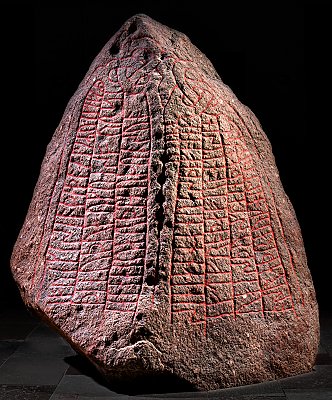 Runestone DR216, a 10th century runestone raised in memory of Frađi, the first among all Vikings, and a terror of men. |
TABLE OF CONTENTS
|
Some of the topics covered in the book:
 |
Many words are used in Viking-age runestones and poetry which have no direct English translation and whose meanings in modern Nordic languages have drifted. In researching for our new book Men of Terror, we needed to painstakingly tease out the meanings of these ancient words, going to extreme lengths to understand them because these words lie at the heart of what it meant to be a Viking. Without that understanding, we could not understand the mindset of the Viking-age people, nor how mindset affected the nature of their combative practices. Two examples of these words are orđstírr and drengskapr. Orđstírr is the eternal part of human existence. The verse from the Viking-age poem Hávamál shown in the photo tells us that orđstírr never dies. Drengskapr is the venerated goal of a Viking and is a term that survives today in legal contracts in modern Icelandic. But what do these words mean when it comes to bloody combat? How do the concepts behind these words drive the behavior of a warrior in the midst of battle? These and many other topics are discussed in the book. |
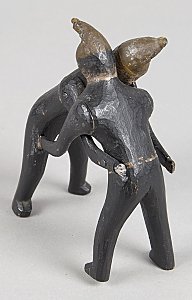 |
Glíma, fang, rjá all are names given to the empty-hand combat of Vikings. Glíma is the only sport and combative activity to have survived the Viking age. Now 1000 years later, the throws of Glíma are still practiced as the national sport of Iceland. Many of the throws even retain the same name in ancient and modern practices. Although the two forms of glíma differ, there is an unbroken line that traces the practice and evolution for 1000 years from the modern times back to the Viking times. Understanding the evolution of glíma allows us to understand the nature of ancient glíma, the empty-hand fighting method of the Vikings. This understanding informs us about Viking combat in general. In our book, we took painstaking efforts to trace the evolution of modern glíma in order to understand ancient Viking empty-hand fighting, and thus, Viking-age combat. This research has led to some surprising conclusions. as it refers to viking empty hand combat, the evolution of Glíma as a national sport and Viking combat in general. The carved wooden men in a wrestling grip shown to the left were at the center of our research into Viking-age empty-hand combat. What we uncovered about this historical artifact from Norway was a revelation in the study of this field. |
|
Our research has taken us to unique places. The right photo shows author Reynir A. at Bessastađir, the official residence of the president of Iceland, where young men practiced glíma more than 200 years ago. It was in this small room that most of the glíma took place, evidenced by contemporary accounts and by the painting behind Reynir which shows glíma competitions in this room. |
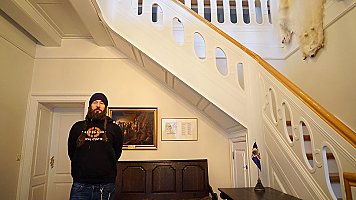 |
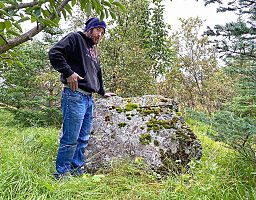 |
The left photo shows author Reynir A. at Hryggbrjótur in west Iceland, perhaps the only stone that can be identified as a Viking-age wrestling stone. These stones had sharp, acute edges that served as a fulcrum over which an opponent's back could be broken during a bout. |
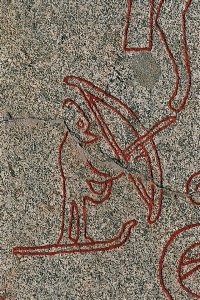 | The bow and arrow differ in significant ways from all the other Viking weapons. Unlike other weapons that might require only a good strong swing, the bow demands more: some technical prowess that comes only with training. Unlike other weapons, the evidence for Viking-age training in archery is extensive. Archery instructors and archery ranges are mentioned in the literary sources, along with practice tools, which are also found in archaeology. Unlike other weapons, there were archery competitions, often presided over by the king. Unlike other weapons, the bow was often the king's chosen weapon. In naval battles, it is said King Óláfr helgi fought most often with his bow. The picture is thought to depicts Ullr, the god of archery, as seen on the Böksta picture stone U855. (Photo: Bengt A Lundberg, RAÄ, CC BY.) |
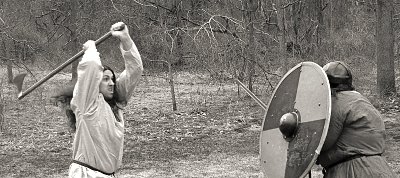 |
The axe can be said to be the iconic weapon of the Vikings. When one envisions a Viking with weapon raised, it is most commonly a two-handed broad axe that springs to mind. In the Byzantine sources, Viking warriors were called axe-wielding barbarians. The axe is a devastating weapon capable of delivering more than three times the destructive energy to the target than a sword, based on both computer models and on measurements. |
 | The photo above shows the technique used when making a head cut with a two-handed broad axe. The computer simulations to either side show the devastating effect of a broad axe on a human skull compared to a bearded axe. Instantaneous energy plots show the ability of the broad axe to deliver much more energy to the target than other weapons, based on computer modeling. |  |
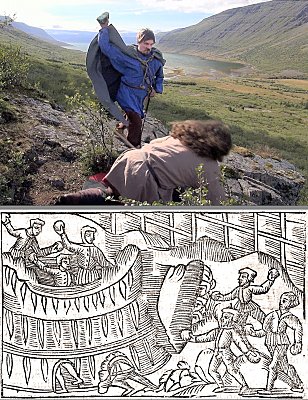 |
Our research on Viking combat revealed that there was an unexpected king among Viking weapons: the weapon that men ran towards when conflict was imminent. It wasn't the prestigious sword, or the iconic two-handed axe, or Óđinn's spear. It was the common stone. Stones were routinely thrown in Viking-age combat. On land, men sought out a battle site with many loose stones for throwing. At sea, ships stopped to pick up throwing stones in advance of an imminent battle. Yet it is a weapon that has not received the study it deserves. Archaeologists don't get grants for excavating rocks, and museum curators rarely create an exhibit of Viking-age stones. How was this brutally effective weapon actually used in combat? These are many other topics are discussed in the book. Top photo: Gísli Súrsson throws stones at his opponents on Einhamar, as told in Gísla saga and depicted in the Hurstwic film The Final Battle of Gísli Súrsson. Bottom photo: An illustration from Olaus Magnus's book Historia de Gentibus Septentrionalibus (1555) showing projectiles being thrown for sport. |
 |
A tactic often used in Viking-age combat was the ambush, which differs from what the reader might envision. While gathering intelligence and spying were key parts to preparing an ambush, concealment was not. How were Viking ambushes planned and executed? When was the tactic used, and how well did it work? These and other topics are discussed in the book. The photo shows an ambush site described in some detail in Droplaugarsona saga. The ambushers, led by Helga Ásbjarnarson, waited on a hill top. When they saw the victims, led by Helgi Droplaugarson approach (solid black arrow), the ambushers came down on them (solid white arrow). The victims intended to fight at a small hill further down the valley (dotted black arrow) but saw they could not reach it in time. Instead, they turned into a ravine (solid black arrow) that offered them some defensive options, and the fight took place there. |
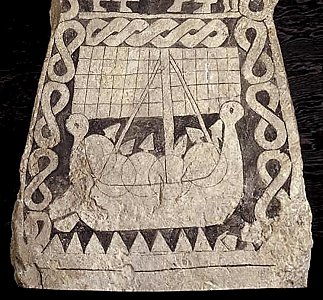 | Vikings raided throughout Europe. Their ships roamed the Baltic Sea, the North Sea, the Irish Sea, the Mediterranean Sea and the North Atlantic Ocean. One of the people they raided were the Muslims in Spain and Portugal: the Moors. The Moors wrote about the Viking raiders, who they called Madjus (magicians, people who worshipped many gods). The Moors admired these raiders for their bravery. Several kinds of raids are described, both on land and sea, but the element in common was that there was moveable wealth to be fought over and won close to where their ships could sail. |
The photo above is a detail for the Smiss picture stone and is thought to depict a Viking raid. (Derived from Christer Ĺhlin, Bildsten frĺn Smiss, Gotland, Creative Commons.)
The plots below show the Viking raids reported in various literary sources by time period (left) and by land where the raid took place (right).
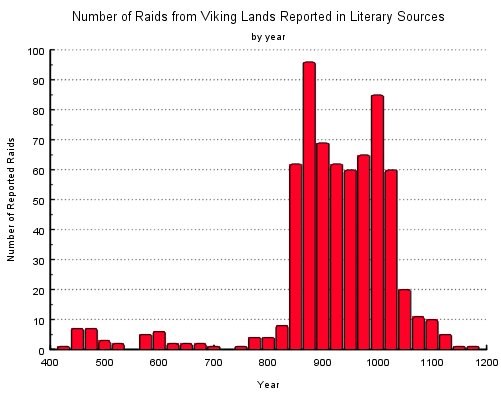 | 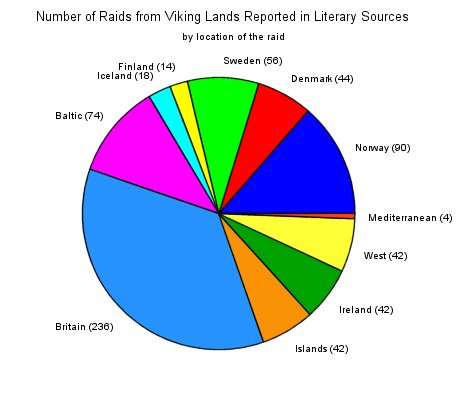 |
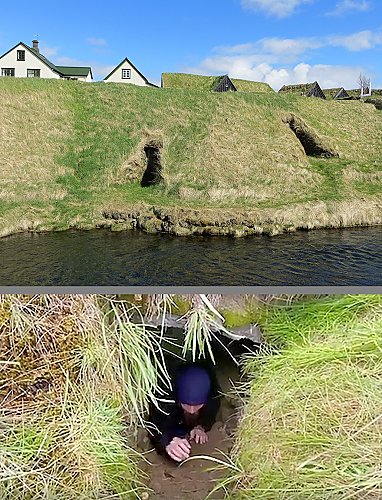 |
In many ways the possibility of an armed attack was at the core of Viking life. Even the architecture of Viking-age houses was centered around the possibility of combat. Houses were often situated to give a tactical advantage to the residents, built on high ground having good visibility of approaching movement (ships, horses, men). According to literary sources, houses were built with secret doors hidden in exterior walls to allow escape from the house should the house be attacked. In Iceland, literary and archaeological evidence at house sites tell of secret escape tunnels leading from the master's bed to a nearby river or stream to permit an escape should the house be surrounded in an attack. These tunnels were so well hidden and kept secret that their existence has been concealed for centuries. The tunnel shown in the top photograph was not detected until the 20th century, even though the house site has been occupied since the 10th century. How were these tunnels used in combat, and what role did they play in defending the house from attack? These and other fascinating topics are discussed in the book. photo: Hermann Jakob Hjartarson (top); Reynir A. Óskarson (bottom). |
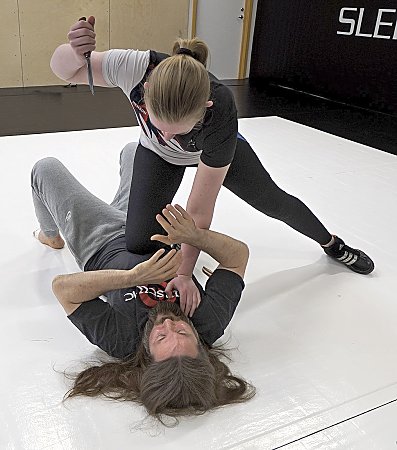 |
In the Viking age, a knife was a tool, and not a weapon. Literary evidence tells us that people routinely carried knives on their belts or slung around their necks. A Viking considered himself "unarmed" when he carried only a knife. Yet a knife might be called into use in a fight when no weapon was available, such as when a man was thrown and pinned down with a controlling ground position, a situation mentioned numerous times in the literary sources. What distinguished the knife from, for example, the sax, its larger brother? How was a knife used when a warrior was forced to wield one in a fight? These topics are discussed in our new book. photo: ©NAEPHOTO |
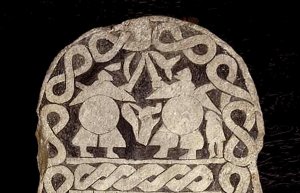 |
The use of shields was probably universal, and men who did not carry a shield when preparing for battle were mockingly asked if perhaps they did not think their enemy knew how to fight. Being able to use a shield was so important in Viking society that the law codes state that a man unable to wield a shield was prohibited from swearing an oath in any legal transaction, effectively blocking him from any participation in government or legal affairs. Even Óđinn himself states in Hávamál that one should rely on a shield for defense. How was this main defense of the Vikings actually put into play in battle? This and other fascinating topics are discussed in our new book. Photo derived from Christer Ĺhlin, SHM 11521, Creative Commons BY 2.5 SE. |
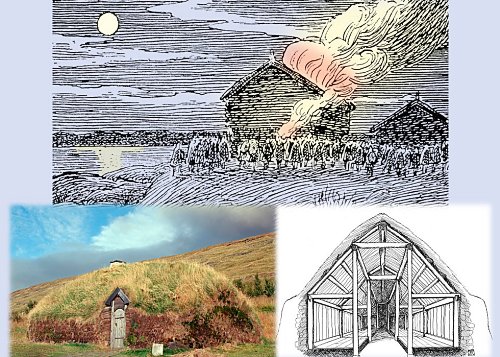 |
It seems that when a Viking-age warrior needed to attack a man in his house, the tactic of choice was to burn down the house with the man inside. Even though the practice was banned by law with the most severe penalties attached, evidence in literary sources suggest it was often practiced. The tactic, which might at first seem unspeakably cruel, had, at its heart, the goal of minimizing casualties, a goal stated explicitly in the literary sources. In many Viking lands, where houses were built of wood, the practice of setting the house ablaze was straight-forward. Yet in Iceland, where most homes were turf-built, starting the fire was more difficult, requiring an attack at one of the few vulnerable places in the house. When was this extreme tactic used and what was the rationale for using it? What did the people inside the house experience and how did they fight back during the blaze? These and other fascinating topics are discussed in our new book. Illustration: Top: Erling surrounds Ossur's house and burns him inside, illustration by Wilhelm Wetlesen, 1899. Bottom left: Viking-age turfhouse at Eiríksstađir, photo by William R. Short. Bottom right: Turfhouse framing details by Andy Volpe. |
 |
A weapon mentioned occasionally in the literary sources is the snćrisspjót. The etymology suggests it was a spear thrown with a string, and indeed, sources written in Latin, such as Saxo Grammaticus, use that description. It was a weapon said to be especially suited for naval battle. When its use is described in the literary sources, it seems to have had greater range and accuracy than a conventional spear. It is also said that the wound from a snćrisspjót was sometimes confused with that from an arrow, suggesting small size. Several small spearheads in the archaeological record seem like a good fit to what we know about the snćrisspjót. What was this unknown weapon and how was it thrown to achieve greater range and accuracy? What are the physics behind its performance? These and other fascinating topics are discussed in our new book. Photos: (Left) Throwing a snćrisspjót in our research lab. Even after the spear has left the thrower’s hand, the string continues to accelerate and guide the projectile. (Below Left) Examining a spearhead in the collection of the National Museum of Iceland, an artifact which seems to have many of the characteristics that might make it a candidate for being a snćrisspjót. (Below Right) Measurements of the energy delivered to the target and of the flight velocity of a snćrisspjót compared to a conventional spear show the benefits of the snćrisspjót. |
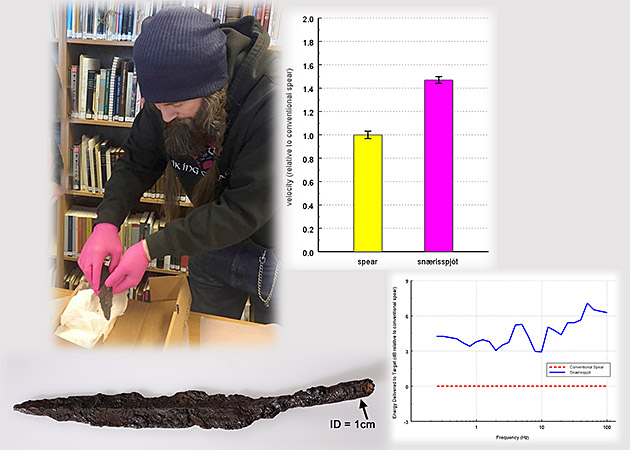
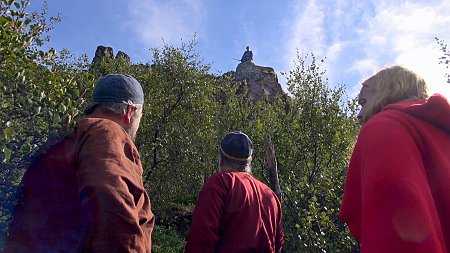 |
When an armed conflict was imminent, men sought out a vígi, a desirable battle location. What made one location more desirable than another? The literary sources tell us that men looked for a place having three features. First, the place needed some elevation above surrounding terrain to better see the enemy and to offer an advantage when using projectiles. It needed a ready supply of loose stones for throwing improvised projectiles. It was desirable to have limited access, such as that provided by a narrow choke point, or by having no access from the rear or sides to minimize the possibility of the enemy advancing and engaging in the vígi. The photo shows a historical vígi described in Gísla saga. When Eyjólfr and his men least expected it, Gísli turned and ran to top of Einhamar, a good vígi, which put Eyjólfr in a much worse position in the fight. These and other fascinating topics are discussed in our new book. Photo: Still frame from Hurstwic's film, The Final Battle of Gísli Súrsson, shot on the location of the historical battle. |
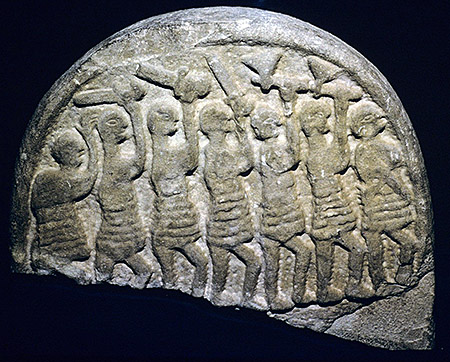 |
Who is a Viking, or in the old language, a víkingr? The ancient literary sources explicitly state what it was to be a víkingr. A víkingr is someone who herja and rćna but who does not stela. Understanding the precise meanings of these words as they were used in the Viking age and their implications is critical to our understanding of the Viking people. For example, whether a víkingr was admired or despised seems to have depended on only one thing: where it was that he was conducting his Viking adventures. The surviving Norwegian law codes make that distinction clear. Who was a víkingr and what was it he did that caused him to gain that title? Many Vikings were admired by their kin and community, and occasionally, even by their victims. The Moors, writing about the Viking raids on Seville, praised the raiders for their courage, even as the Vikings burned down the mosque with their fire arrows. These and other fascinating topics are discussed in our new book. Photo: A stone carving from Lindisfarne, thought to be a gravestone depicting a Viking attack on the site. |

In the Viking age, there were men we call professional duelers who made their fortunes through dueling. They traveled from settlement to settlement asking for the hand of a marriageable woman, along with the wealth of the woman's family. If the man of the family didn't yield to the dueler's demands, he was challenged to a duel.
The similarities between the activities of these professional duelers and of Viking raiders are so great that they were both called víkingr in the old language.
How were duels conducted in the Viking age? How were the challenges issued, and how were the fights conducted?
These and other fascinating topics are discussed in our new book.
Photos above: (left) A Viking duel with shield holders, illustrated by Barbara Wechter. (Center) A portion of the Smiss picture stone thought to illustrate a duel. (Right) A Viking duel with shield holders being tested in the Hurstwic research lab, caught at the moment that a shield was split.]

The sax was the weapon of common men, as well as of giants, and other paranormal beings: men of extraordinary strength. It is a tool for cleaving, as revealed by the design of the weapon, by the physics of its movement, by and the etymology of its name. In the literary sources, it was an effective weapon, lethal in a higher percentage of cases than any other weapon.
It's clear that the sax was in use in the Migration period, long before the start of the Viking age. Yet by the Viking age, it was not a particularly common weapon, based on both archaeological and literary sources.
How did this come to pass? What changes were taking place in combat and in the evolution of weapons that made the sax less desired for combat than other weapons by the start of the Viking age?
These and other fascinating topics are discussed in our new book.
Photo derived from Arnold Mikkelsen, Enćgget svćrd Alling Sř., Nationalmuseet, Danmark. Creative Commons.
New York Times Book Review
Amazon Reader Reviews
|
|
|
Blog Reviews on-line
"This is a selfless, genuinely openminded approach to understanding a long-departed culture, and it's one of the things that makes Men of Terror especially good. … I highly recommend it if you have any interest in the Viking Age or medieval military history at all." — Jordan M. Poss blog |
"This densely packed work … is a necessary addition in the personal library for every Viking reenactor, Viking combat student, and many heathens who want to be better informed about the Viking era." — Odin's Warrior Tribe book review |
Advance Reader comments
|
"As an archaeologist specializing in the Viking age, this excellent book gave me new perspectives on many things and opened my eyes to new interpretations. It’s an essential book to all people researching the Viking age, and to all people interested in that time period." — Margrét Hrönn Hallmundsdóttir, archaeologist, Náttúrustofa Vestfjarđa (Westfjords Iceland Nature Research Centre) |
"Neither a rehash of later medieval fight manuals or of fanciful stage combat, this new book provides a fresh and informed look at actual Viking-Age combat drawn from the Sagas and other contemporary writings, from surviving examples of arms and armour, and from active scientifically rigorous experimentation based upon that information conducted by skilled martial artists specifically focusing on Viking culture." — Lee A. Jones, contributor, Swords of the Viking Age |
"The authors' research into the empty-hand combat of the Vikings has created new, deep, and insightful connections between the ancient combat and the modern sport of Iceland, glíma. Through a multi-layered investigation of all the available sources, the authors have created a comprehensive picture of the empty-hand combat of the Vikings. Their research has been so extensive, that I, as president of the Glíma association, have embraced it." — Svana Hrönn Jóhannsdóttir, chairman, Iceland Wrestling Association (Glímusamband Íslands) |
"I see many similarities between today's Special Operations warriors and these warriors of the past. Comradery, mindset, training and skill with various weapons, high speed modes of infiltration and contact with other peoples and cultures are just a few of these similarities. As I studied and researched with Hurstwic, I realized that this unique and diverse group was able to break barriers and cast-off preconceived beliefs and look for the unbiased truth." — Robin D. Cooper, US Army Special Forces, retired |
Lectures and Media Appearances related to the book release
18-Aug-2021: A radio interview with Reynir A. Óskarson broadcast on Rás 2.
21-Aug-2021: Ţjóđminjasafn Íslands (National Museum of Iceland). A gallery walk-through, interpreting artifacts in the museum's collection in the light of the research findings in our book.
22-Aug-2021. A lecture for Rimmugýgur, the Viking re-enactment group in Iceland.25-Aug-2021: Viking Weapons and Combat, Part 2, an on-line interview with Dr. William R. Short conducted by Dr. Jackson Crawford
26-Aug-2021: Hrafnseyri. A presentation on the book, a presentation on glíma, and a glíma demonstration for the team of archaeologists working on site this summer.
27-Aug-2021: Hákólasetur Vestfjarđa (University Centre of the Westfjords). A private lecture for students in the Icelandic Courses on how our research into the ancient language of the Vikings informs us about Viking combat and about how the echoes of that combative society linger in the modern Icelandic language.
29-Aug-2021: Sauđfjársetur á Ströndum. A lecture about the book for folklorists and for the general public.
30-Aug-2021: Vínlandssetur (The Leif Eiriksson Center). A public lecture about the book.
31-Aug-2021: A meeting with the President of Iceland at his official residence at Bessastađir to present him with a copy of our new book and to discuss with him some of the intriguing research results detailed in the book.1-Sep-2021: Háskólinn í Reykjavík (University of Reykjavík). A lecture about the science and physics behind the research findings in our book.
19-Sep-2021: Ashokan Sword Seminar, hosted by New England Bladesmith's Guild. A lecture about the book, with a focus on the weapons tests and measurements.
4-Oct-2021: Interview on Hringbraut (Icelandic television) about the book, with a focus on our research into glíma.
28-Oct-2021: Háskóli Íslands (Univeristy of Iceland). A presentation and demonstration for a class, with a focus on our research into glíma.
18-Nov-2021: Worcester Art Museum. A Masters Series Lecture on topics from the book as they relate to a newly acquired Viking sword being added to the museum’s collection.
3-Dec-2021: Northborough Historical Society. A lecture for the general public.
22-Jan-2022: Scandinavian Cultural Center. A lecture for the general public.
Links to more recent media appearances can be found on our media appearance page.
|
|
|
|
|
|
|
©2021-2025 William R. Short |